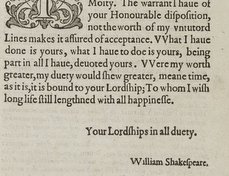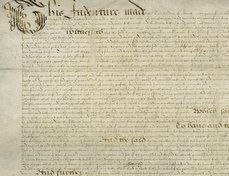From the collections of: THE BRITISH LIBRARY
Terms of use
The British Library has graciously contributed the above images to Shakespeare Documented under a Creative Commons Public Domain Mark.
Copyright status of the manuscript and unpublished Materials: The 1988 Copyright, Designs and Patents Act (as amended) states that unpublished literary and artistic works remain in copyright in the UK until at least 31 December 2039. Therefore important parts of the library’s collection remain in copyright, including very old manuscripts. However for unpublished material created many centuries ago and in the public domain in most other countries, the Library believes this material to be very unlikely to offend anyone. As an institution whose role it is to support access to knowledge, we have therefore taken the decision to release certain digitised images technically still in copyright in the UK under the Public Domain Mark.
Document-specific information
Title: A collection of poems written by Sir Walter Raleigh, Sir Henry Wotton, Dr. H. Icing, Hugh Holland, Sir N. Throckmorton, W. Basse, Dr. Sincro", W. Str., G. M., W.P., Wm. Reynolds, and P. Pembroke, and some anonymous persons. fo. 63.
Repository: The British Library, London, UK
Call number and opening: Lansdowne MS 777/2, fol. 67v
View online bibliographic record
Alan H. Nelson, "Manuscript copy of William Basse's elegy on William Shakespeare," Shakespeare Documented, https://doi.org/10.37078/573.
British Library, Lansdowne MS 777. See Shakespeare Documented, https://doi.org/10.37078/573.
William Basse (1583?-1653?) apparently attended Oxford University before entering the service of Francis Lord Norris (or Norreys) (ODNB). An accomplished poet, Basse composed an elegy on William Shakespeare sometime between the latter’s death on April 23, 1616 and the publication of the First Folio in 1623. The most informative copy of Basses’s elegy survives in British Library MS Lansdowne 777, as shown here, titled: “On Mr Wm Shakespeare /he dyed in Aprill 1616.”
Basse’s elegy contrasts the burial of Spenser, Chaucer, and Beaumont in Westminster Abbey with the burial of Shakespeare in Holy Trinity Church, Stratford-upon-Avon . The three are first told to squeeze together to make room for Shakespeare-- on second thought, they may lie undisturbed; Shakespeare will be buried alone in Stratford. There he will experience “unmolested peace,” and an “unshared cave,” where he will be owner and not merely a tenant (or one of many tenants) of his grave. It would be a higher honor to be buried “by thee” in Stratford than to be buried in Westminster Abbey.
Although it is not possible to date the composition of Basse’s elegy precisely, it is possible to infer a relative date by observing that it openly refers to Shakespeare’s funeral monument in Holy Trinity Church, Stratford, erected after his death in 1616:
Vnder this carued marble of thine owne
Sleepe rare Tragoedian Shakespeare, sleep alone
That Basse’s elegy was not only composed but widely disseminated before 1623 is evident from Ben Jonson’s allusion to the poem in his own elegy, published in the First Folio under the title, “To the memory of my beloued, the Author, Mr. William Shakespeare”:
My Shakespeare, rise; I will not lodge thee by
Chaucer, or Spenser, or bid Beaumont lye
A little further, to make thee a roome:
Thou art a Moniment, without a tombe
Jonson clearly assumed that any reader of the Shakespeare First Folio would recognize his allusion to Basse’s elegy. Therefore it is possible to estimate the date for Basse’s elegy as 1618 to 1620, taking into consideration that Shakespeare’s monument had to be commissioned, carved, transported and installed prior to the poem’s composition, and that the elegy had to have time to be disseminated prior to the First Folio’s typesetting ca. 1623. It is even possible that Basse composed his elegy for a formal dedication of the monument.
The thirty-five manuscript copies of Basse’s poem which have been discovered so far, mostly from the seventeenth century, constitute a veritable laboratory for observing the variant spellings and hyphenations of the Shakespeare surname. Although the manuscript copies give various titles to Basse’s elegy, at least three copies agree in their title with the Lansdowne copy shown here, accurately recording the month of William Shakespeare’s death as April 1616. At least seven preserve the “Master” in the title. A few somewhat arbitrarily switch the names “Spenser” and “Chaucer.”
The copy shown here is part of a manuscript of which the majority is in a hand evidently of the second quarter of the seventeenth century. Though the scribe remains unidentified, the hand is so distinctive that it should be easy to match to another manuscript. The chief idiosyncrasy, which occurs at the beginning of lines 13 and 15, is a majuscule, or uppercase, “T” followed by an “h” without a secretary-style descender (the part of a letter that “descends” below the line). The “T” (see also lines 2 and 5) is made of a looped top bar over a body made of a counter-clockwise circle which closes on itself as it rises back to the top. A note on the flyleaf reports that the manuscript is made up of several numbered parts or “Articles.” Article 1 contains poems by William Browne “of the Inner Temple” (ca.1590-1645). Though it may be tempting to assign the manuscript to Browne himself, the idiosyncratic “Th” combination is not replicated in manuscripts known to be in Browne’s hand or closely associated with him (such as Bodleian MS Ashmole 767, 830, f. 288). Article 2 contains poems by other poets. Many of these are elegies, and many accurately record the date or year of death of the subject, or else the year can be inferred, as in the case of Prince Henry, who died in 1612. The second section includes the Basse elegy shown here.
In addition to its wide manuscript circulation, Basse’s poem also appeared in print five times from 1633 to 1647. It was first included in the “collected” poetical works of John Donne (1633, sig. Y3): but the incorrectly attributed poem was purged from subsequent editions. It next appeared in Poems: Written by Wil. Shake-speare, Gent. (1640, sig. K8v), with the full title, “On the death of William Shakespeare, who died in April, Anno Dom. 1616.” In the same year the poem appeared in Witt’s Recreations (1640), along with tributes to other wits, including “Sir John Suckling,” “Mr. Francis Beaumont and Mr. John Fletcher gent.,” “Mr. Benjamin Johnson,” and “Mr. George Chapman on his Translation of Homers works into English meeter.” Basse’s poem (No. 5) appears under the title “On William Shake-speare." This volume saw a second edition in 1641 (Wing M1720, Poem 144, sig. R7v-8). The second edition of Poems: Francis Beaumont (1653) includes the poem as “On William Shakespeare” in a kind of appendix (sig. M) which contains elegies on many poets.
Wells and Taylor, Textual Companion, pp. 163-4, list twenty-seven manuscript copies of Basse’s elegy; seven more are identified by Brandon Centerwall, "Who Wrote William Basse’s ‘Elegy on Shakespeare’?: Rediscovering a Poem Lost from the Donne Canon," Shakespeare Survey 59, (2006): 267-84; and a thirty-fifth copy was recently identified by Tom Reedy, “William Dugdale on Shakespeare and His Monument,” Shakespeare Quarterly 66 (2015), 188-96.
On Mr Wm Shakespeare
he dyed in Aprill 1616.
Renowned Spencer, lye a thought more nye
To learned Chaucer, & rare Beaumont lye
A little neerer Spenser to make roome
For Shakespeare in your threefold fowerfold Tombe
To lodge all fowre in one bed make a shift
Vntill Doomesdaye, for hardly will a fift
Betwixt yis day & yat by Fate be slayne
ffor whom your Curtaines may be drawn againe.
If your precedency in death doth barre
A fourth place in your sacred sepulcher,
Vnder this carued marble of thine owne
Sleepe rare Tragœdian, Shakespeare sleep alone
Thy vnmolested peace, vnshared Caue
Possesse as Lord not Tenant of thy Graue
That vnto us and others it may be
Honor hereafter to be layde by thee.
Wm Basse
Written by Alan H. Nelson
Sources
Brandon Centerwall, "Who Wrote William Basse’s ‘Elegy on Shakespeare’?: Rediscovering a Poem Lost from the Donne Canon," Shakespeare Survey 59 (2006): 267-84.
Tom Reedy, “William Dugdale on Shakespeare and His Monument,” Shakespeare Quarterly 66 (2015): 188-96.
Stanley Wells and Gary Taylor, eds., William Shakespeare, A Textual Companion (Oxford: Clarendon Press, 1987).
Last updated January 25, 2020










